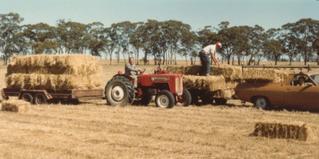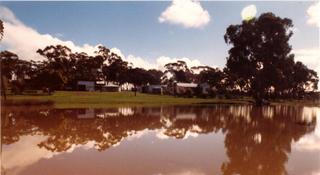
Carting hay

" Tanderra" in reflected glory
We stuck fairly closely to our original plan, we would run Merino ewes with Border Lester rams for good wool and very saleable lambs, then the price of wool took a substantial dive so we went looking for an alternative.
We heard good reports about sheep that grew wool for use in carpet making, there were several breeds, we decided to give this a try as the wool prices were very stable, so we bought a flock of Tukidales.
These were the exact opposite to what we had been striving for in the past; they had very coarse wool which grew about 6 inches every 6 months, so they needed to be shorn twice a year instead of once.
Our winter shearing, when there was green grass was very good but the summer shearing dropped off in both quality and length, Tukidales are a “green grass” sheep!
So once more we bought Merinos, this time buying a new flock each year, we usually managed to make a profit when we sold them and we were getting the better wool again. (wool prices had picked up a bit too.)
This update is about half way mark, after we had been here for 7 years, our herd of cattle now had grown to about 25 so were also taking up a little more time, the hundreds of trees we had planted, mainly in the first couple of years, were all growing well, (I went back for a look this year when I was in Victoria, they are now quite substantial groves of trees)
Over the years we built several sheds and did substantial repairs to others, we extended the house and put a new roof on it, we upgraded our water system again, put in sprinkler systems to keep everything damped down if we were threatened by bush-fire, we had always kept about a dozen hens so always had fresh eggs, life was good.
We spent about 14 years at “Tanderra” (an aboriginal name meaning “place of rest” that was a joke!) for about 10 of those years we also took School photos.
Life on the Land
You’d reckon he would have known better
Than to settle for “life on the land”
With all of the cautions and warnings
But he just had to try his hand.
Where to settle’s the question
That starts uppermost in his mind
But most of the climate’s unkind.
No thought of droughts down there
But with two or three real dry seasons
The threat of his ruin is near.
His sheep just fall by the wayside
They simply don’t get enough feeds
The bit of rain that he’s getting
Won’t promote any growth but the weeds.
In the evenings the dark clouds gather
As though the heavens will burst
But each morning’s light shows
His land is still dying of thirst.
The hay that was stacked in the hayshed
Is nearly all used up now
There are only the scraps that the mice left
To show for the sweat from his brow.
The frosts have settled in earnest
The white landscape can look very nice
But it burns of any new grass shoots
Well at least it kills of the mice.
In between there have been times of plenty
Plenty of locusts and plenty of mites
To chew off the pasture he’s put in
And cause him more sleepless nights.
For all the setbacks and heartaches
He says, “The life’s not that bad”
But despite the brave front he puts on
He ain’t got the cash that he had.
Right now the farms looking pretty
There’s a tinge of green showing through
But it’s short, and now it’s stopped growing
And there’s not a dammed thing he can do.
The garden looks neat and tidy
The sheds all look straight and true
The fences are in good condition
There’s a crop in the ground, growing too.
Sounds like everything’s rosy
It’s just there’s no rain, or cash flow
To meet the bills as they come in
That’s dealing the crippling blow.
Who’s helped him through all of his hardships?
Was it Dalgety’s? Or Elder’s? The Bank?
No, the girl that he married
Is the one he really must thank.
These are the trials of farming
To be weathered and beaten in time
Have enough patience to hang on
And everything works out just fine.
Peter Holt

No comments:
Post a Comment